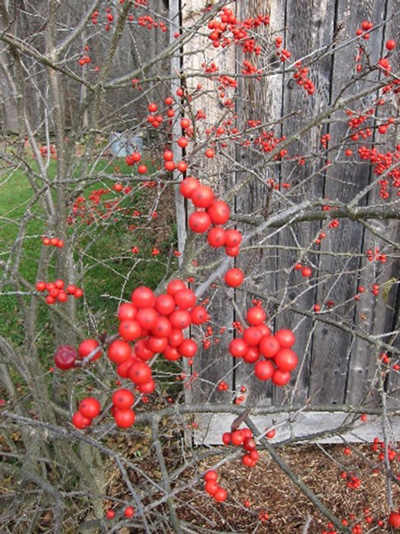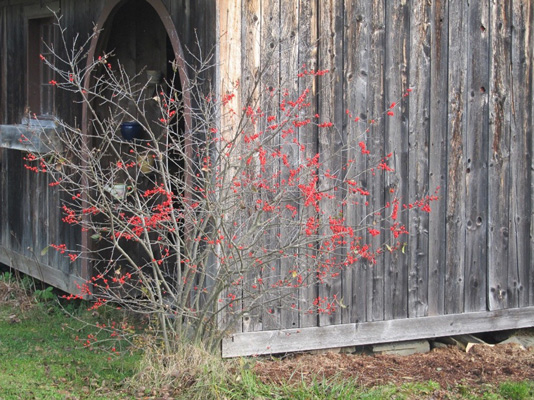Welcome Winter Color by Author Jo Bush
Winterberry plants (Ilex verticilata) are shrubs in the Holly family and found in the eastern United States and southeastern Canada. Winterberries are known for their berries, which are an important source of food for some birds. At my Vermont home are four winterberry plants. Three are females and produce berries; the fourth is the pollinator male. The flowers of winterberry are inconspicuous, so these shrubs are grown for the beauty of the berries on the bare stems in winter.

Winterberries and Robins
I’m not the only one pleased to see the Winterberry shrubs burst with berries in the late summer. As the weather grows colder, crowds of robins arrive to gorge themselves on the fruit. I’m happy to provide food for the birds, but wish they weren’t so greedy.
When the shrubs were young, berry production was limited, and the robins left the branches completely bare. Now that the bushes are more mature, they’re able to produce enough to feed the robins, with some leftover. I look forward to the modest show of remaining bright red berries against the snow-covered branches.
Gold Berries
One of the Winterberry shrubs, which I’ve named ‘Goldfinch’, produces gold berries instead of red. Interestingly, Goldfinch is mostly ignored by wildlife and the abundant gold berries remain through the winter. I’ve read it’s typical for birds and mammals to prefer red fruit over other colors. They’ll often ignore yellow, orange, and golden fruit until nothing else is left.

The Chipmunk
Last year, a particularly dedicated chipmunk joined the robins in systematically stripping the berries of the shrub I named ‘Berry Nice.’ I’d often spy the leaves twitching, only to see the chipmunk tumble out of the shrub and trundle off to his bolthole in the stone wall. He didn’t appear this year. Perhaps that’s why Berry Nice still has a chance of fulfilling its promise.

About the Author
Jo is the author of Time and Garden, a collection of essays about life, gardening, and the natural world.
To learn about our latest science-based children’s books and workbooks, to read our latest blog posts about reptiles, birds, cats, and gardening, in a variety of locations, and about how the books come to be, what inspires an author to write, and many more interesting aspects of the publishing business, fill in the box below and we will add you to our email list.
Thank you!



